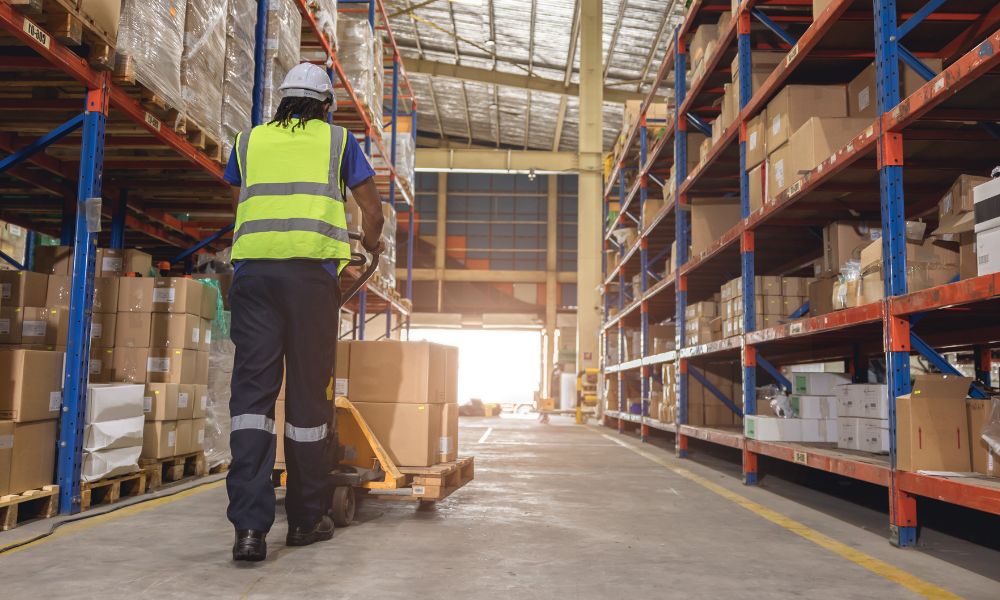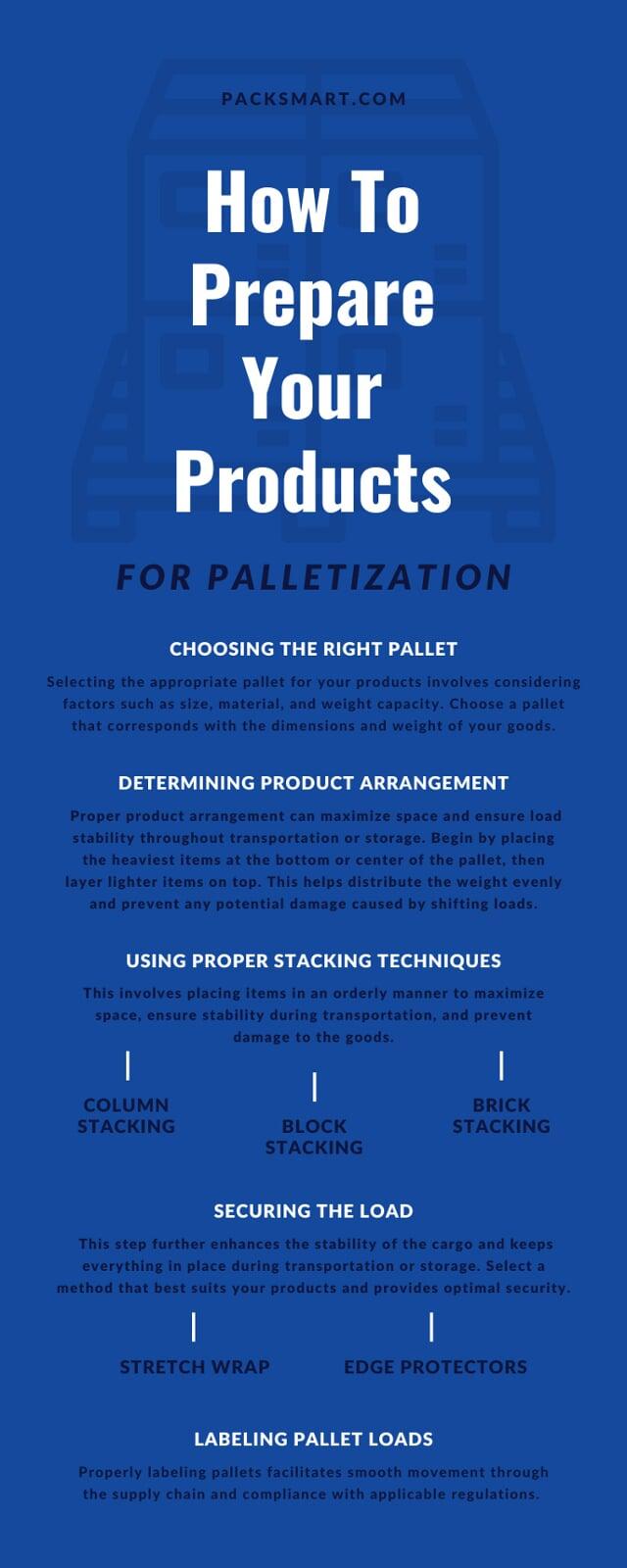
When shipping products or warehousing them, palletization ensures they stay in perfect condition. Palletization refers to the process of loading and arranging products on a pallet in a systematic manner. This technique helps to optimize storage space, increase transportation capacity, and maintain the stability of cargo loads. Discover some important tips on how to prepare your products for palletization to improve product transportation and storage.
Choosing the Right Pallet
Selecting the appropriate pallet for your products involves considering factors such as size, material, and weight capacity. Choose a pallet that corresponds with the dimensions and weight of your goods. For instance, a pallet made from wood or plastic might be suitable for lightweight items but not for heavy equipment. Take the time to research and compare wood, plastic, and metal pallets to find the best one for your specific needs.
When considering material, evaluate the nature of your product and where it will be stored or shipped. For example, if your product might be exposed to moisture, consider using a plastic pallet that is resistant to rot and decay. Alternatively, metal pallets, while more expensive, offer durability and longevity, proving advantageous for heavy or sharp objects.
Determining Product Arrangement
Once you’ve selected the right pallet, you can arrange your products effectively. Proper product arrangement can maximize space and ensure load stability throughout transportation or storage.
Begin by placing the heaviest items at the bottom or center of the pallet, then layer lighter items on top. This helps distribute the weight evenly and prevent any potential damage caused by shifting loads.
Also, avoid letting goods hang over the pallet edge, as overhangs may cause product damage. Aligning boxes or containers in an interlocking pattern makes for a more secure load, while leaving adequate gaps between them prevents crushing during pallet stacking.
Using Proper Stacking Techniques
Stacking is an important step in preparing products for palletization. This involves placing items in an orderly manner to maximize space, ensure stability during transportation, and prevent damage to the goods. Some common methods include column stacking, block stacking, and brick stacking. Choose the technique that best suits the shape, size, and weight of your products.
Column Stacking
Column stacking is a straightforward method where items are stacked directly on top of each other to create tall columns. This technique maximizes vertical space and is especially useful for uniformly shaped and sturdy items that can withstand the weight. However, it offers limited stability as stacks can easily topple if disturbed.
Block Stacking
Block stacking involves creating distinct blocks with gaps in between each column stack. These gaps improve stability over the column stacking method and provide easier access to individual items or stacks. However, this method does not utilize space as efficiently because of the gaps left between the blocks.
Brick Stacking
Brick stacking alternates the positioning of items in each layer, creating an interlocked pattern similar to a brick wall. This method offers the most stability and is best suited for items that are less uniformly shaped or not sturdy enough to stand the weight of a column stack. While it’s a time-consuming technique, the increased stability and safer handling make it a worthwhile consideration.
Each of these techniques has its advantages and is best suited to different types of items. Your choice of stacking method should depend on the specific characteristics of your products, including their dimensions, weight, and sturdiness, as well as your storage and access requirements.
Automating With Palletizing Equipment
Preparing your products for palletization also involves using palletizing equipment effectively and safely. Equipment like pallet jacks, forklifts, and automated systems can significantly aid in the preparation process. Make sure that staff are properly trained to operate these machines to prevent accidents and ensure an efficient workflow.
Palletizer machines help your packaging line attain higher production rates and maintain quality. Several palletizing machine options are available, including robotic palletizers, layer palletizers, and gantry palletizers. While their operations may differ slightly, the common thread is that they enhance efficiency and precision in product stacking to reduce the risk of product damage.
Palletizing equipment also offers significant ergonomic benefits. By reducing the need for manual lifting and stacking, these machines help prevent workplace injuries, which can lead to less downtime and lower compensation costs.
Securing the Load
To keep products stacked and organized, you must secure each load using straps, wraps, or other supplies. This step further enhances the stability of the cargo and keeps everything in place during transportation or storage. There are many options available, including stretch wrap, edge protectors, and banding. Select a method that best suits your products and provides optimal security.
Stretch Wrap
Stretch wrap is a highly elastic plastic material that keeps items tightly bound, minimizing load shifting or toppling during transit. The film also shields goods against dust, moisture, and external elements.
To wrap loads securely, begin at the base and move upward, ensuring each layer overlaps the previous one by at least 50 percent for maximum stability. For irregularly shaped loads, consider multiple passes to cover all areas.
Edge Protectors
Edge protectors distribute the restraining forces of straps or bands over a larger area and help protect the cargo from damage. Edge protectors should be placed at points where strapping will be applied, particularly on sharp corners or edges. These protectors can consist of materials like cardboard, plastic, or metal, and your choice should depend on the weight and nature of your load.
Labeling Pallet Loads
Properly labeling pallets facilitates smooth movement through the supply chain and compliance with applicable regulations. Precise and consistent labeling ensures the goods are treated correctly during every stage of the supply chain, reducing the risk of misplacement or mishandling. Effective labeling not only enhances operational efficiency and accuracy but also contributes significantly to successful order fulfillment and customer satisfaction.
Labeling assists in the efficient tracking and handling of goods. The labels should be clear, legible, and securely affixed to the pallet to withstand the rigors of transport and storage. They should contain essential information like the product name, quantity of items, lot number, and production date. Barcode labels are particularly useful as material handlers can swiftly scan them to retrieve real-time product information, which aids in inventory management and reduces potential errors.
Securing products for storage and handling helps businesses maintain product safety, boost operational efficiency, and ultimately enhance customer satisfaction. Palletization requires careful selection of pallets, strategic product arrangement, effective stacking techniques, and clear labeling. Furthermore, using palletizing equipment improves packaging quality, efficiency, and consistency. Enhance your overall supply chain operations with these helpful tips.

